futurehermit
Deity
- Joined
- Apr 3, 2006
- Messages
- 5,724
I feel like, on average, there are 4 types of capital locations you run into in BTS, so I thought it might be useful to discuss them and give some examples. Hopefully people will add their own contributions to this thread to turn it into a nice educational resource.
Capitals are generally your most important cities because they come first and feature the most development as compared to newly founded cities later in the game. The capital can also benefit from the powerful bureaucracy civic increasingly its potency.
I also feel like different traits and starting techs provide good or bad (or in between) "fit" with the different capital types, so I will mention that as well. Feel free to agree/disagree and chime in on your own thoughts about this.
Without further ado, here are the 4 types:
Bureaucracy Capital aka Commerce Capital:
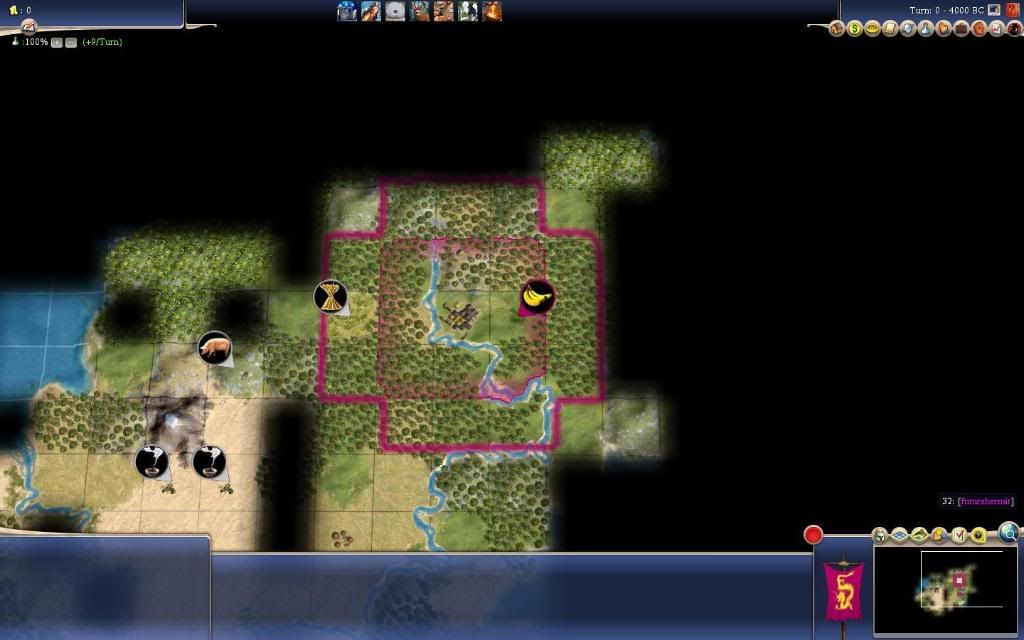
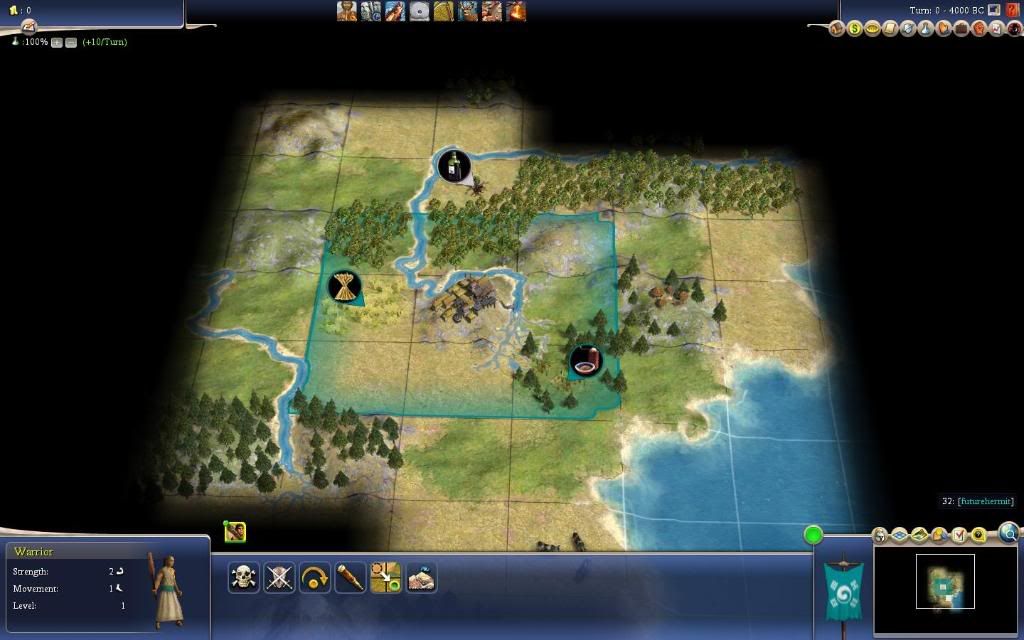
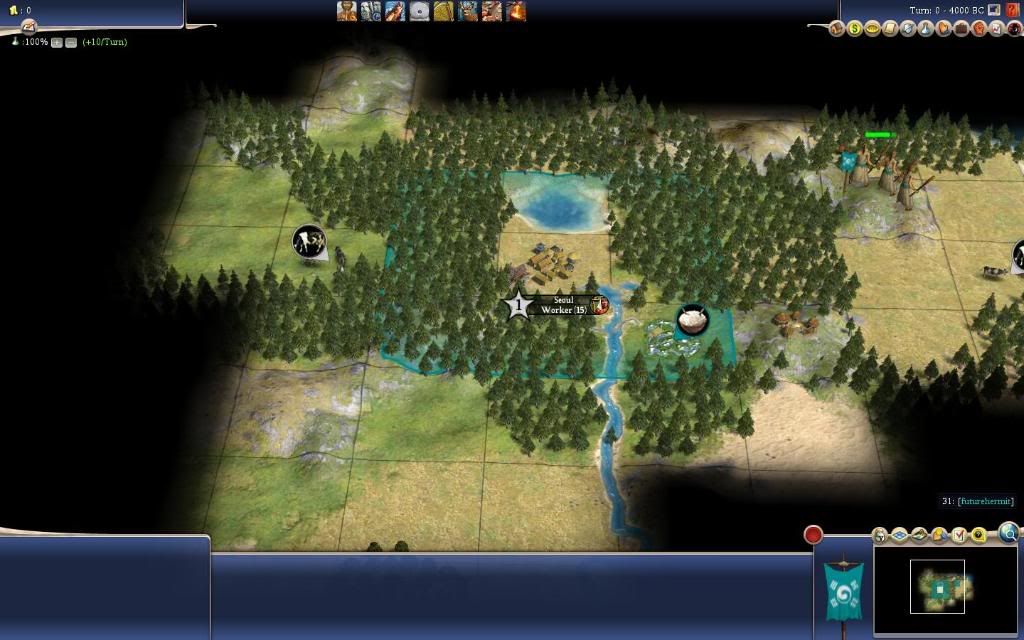
Description
This is the kind of capital, usually on a river, where you can build 10+ grassland/floodplain cottages--mostly riverside--and have more than one food specials to drive growth. Ideally you will also have some nice production tiles, and the food to work them, since bureaucracy also impacts production. However, the key here is working a pile of cottages to drive research and support the costs of a growing empire.
Good Fit
This capital provides a good fit for a variety of strategies. However, traits such as charismatic ( ), financial (
), financial (  ), and expansive (
), and expansive (  ) probably fit best. Health, happiness, and the extra commerce is what it's all about here. Monarchy is a key tech for the HR civic to drive vertical growth. CS for bureaucracy is also key. Teching Monarchy --> CS by 1AD (normal speed/monarch) is a good timeline for this capital. Getting an academy off of a GS is also key. In terms of starting techs, whatever you need to grow is important. Since you are inland (generally) that usually means agriculture is a good starting tech leading to animal husbandry. Wheel is also helpful as a prereq for pottery, especially if you have floodplains. I would say that ag-wheel might represent the best starting techs for this kind of capital, but mining is not without its merits either.
) probably fit best. Health, happiness, and the extra commerce is what it's all about here. Monarchy is a key tech for the HR civic to drive vertical growth. CS for bureaucracy is also key. Teching Monarchy --> CS by 1AD (normal speed/monarch) is a good timeline for this capital. Getting an academy off of a GS is also key. In terms of starting techs, whatever you need to grow is important. Since you are inland (generally) that usually means agriculture is a good starting tech leading to animal husbandry. Wheel is also helpful as a prereq for pottery, especially if you have floodplains. I would say that ag-wheel might represent the best starting techs for this kind of capital, but mining is not without its merits either.
GP Farm Capital aka Food Capital:
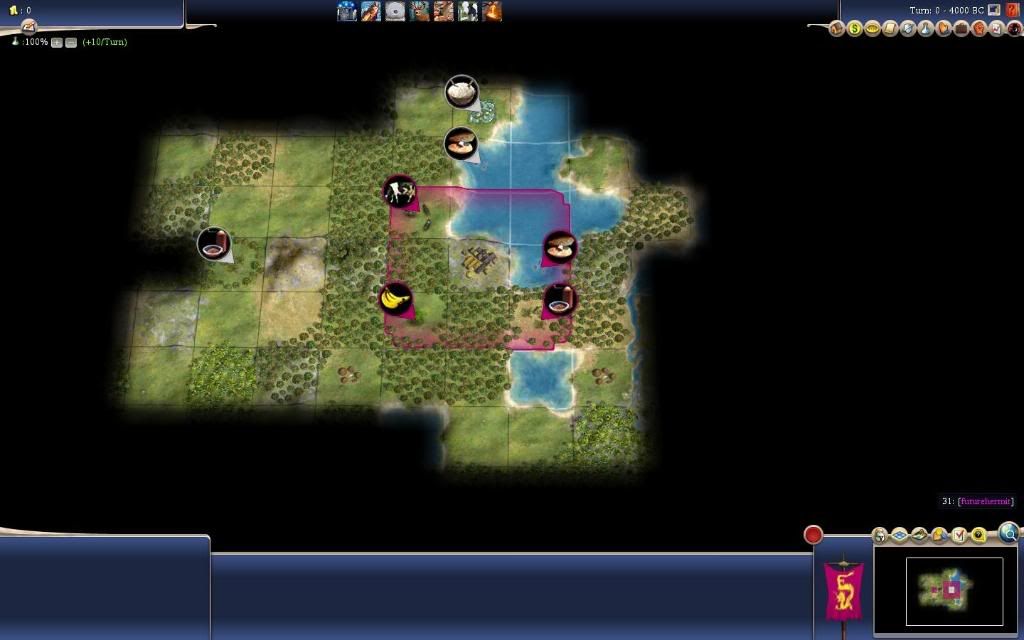

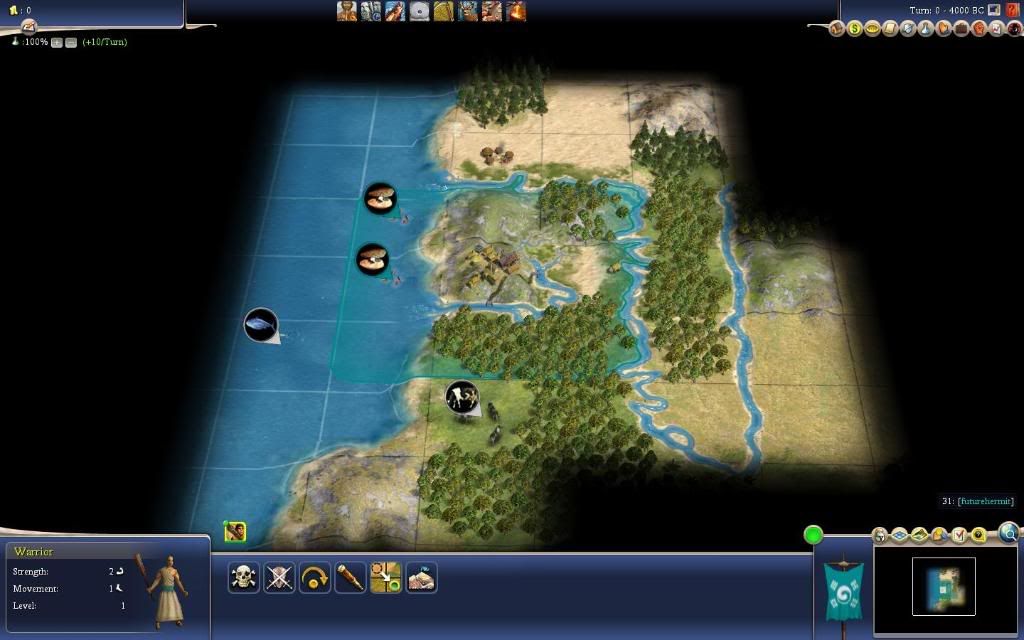
Description
These capitals are often on the coast. Because there are a number of coastal tiles, cottages are less of an option making bureaucracy less potent. These capitals also generally have incredible food surplus making the capital ideal for running specialists. Settled great people supports research or bulbing and tech trading is a powerful option as well, especially at higher skill levels. Earlier on, these cities make extremely powerful whip-driven-production cities (slavery).
Good Fit
Philosophical is a natural and powerful fit here, but industrious (pyramids/gl/glh/ne/parthenon) can be helpful assuming sufficient production and/or stone/marble. Expansive for the vertical growth is also not without its charm. In terms of starting techs it's all about food. Since these capitals tend to, on average, be on the coast, fishing is nice. Agriculture is also good. Ag/fishing might be a nice starting tech pair although mining is also good since it leads to BW for the whipping. CoL is important because it unlocks caste system and also frees up a philosophy lightbulb for the pacifism civic.
Production Capital aka Hammer/Low Food Capital:

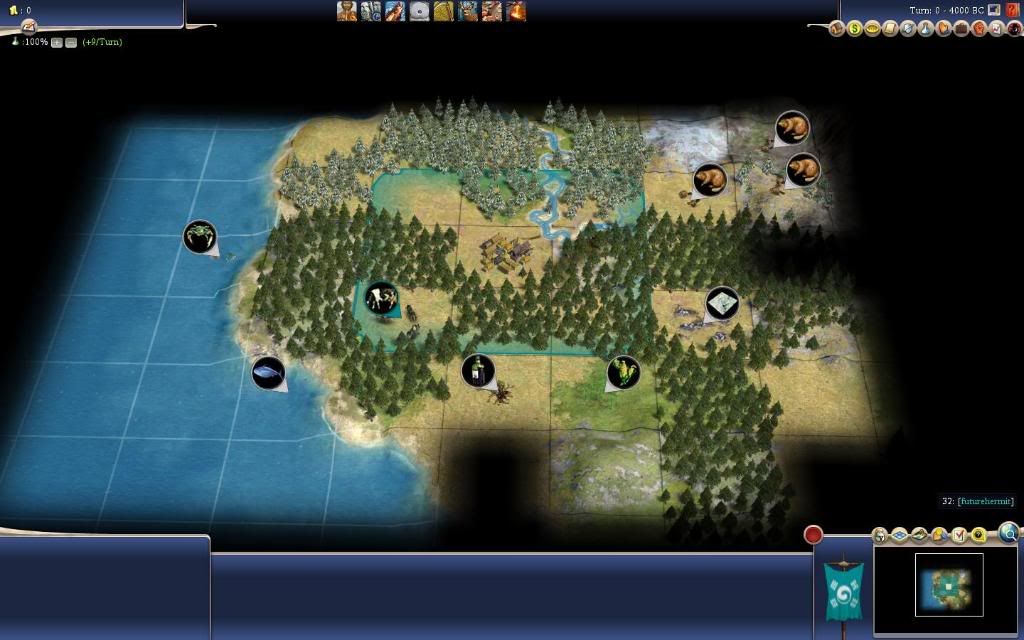

Description
These capitals are fairly unique to BTS as they did not appear in vanilla/warlords--at least not with the same frequency. They generally feature low food in the sense that you need to lay down grassland farms to support all of the production (i.e., hills) that you have. Interestingly, these capitals also tend to be nearly completely blanketed in forests, which adds to your production potential. Growing quickly and whipping is generally not an option here and cottages are pretty much out of the question. Because of the low food specialists are also not an option. That means research from your capital is generally not happening, at least not in the traditional sense of specialists and cottages. However, Obsolete and others like him have turned us on to the wonder/production economy of cranking out wonder after wonder and settling the great people under representation. This is a powerful alternative for this unusual capital location in order to keep research at acceptable levels.
Another alternative for this capital location is rushing or rexing. Although these options are also available for the bureaucracy capital to a certain extent, the production capital has the production available to chop and hard produce a lot of military quickly or workers/settlers to expand your military horizontally. Unfortunately, your capital doesn't provide you with the commerce to support this expansion so you should be prepared to develop this economic support from your conquests and/or your newly created/captured cities. Otherwise you risk overexpansion and stifling your economy.
Good Fit
If you go the wonder route industrious is obviously handy to have although philosophical is beneficial as well. Mining is the key starting tech here because you're going to need BW sooner than later to start chopping all of those forests (at the very least you will probably need to chop a few so you can mine some hills or farm riverside grassland). In terms of a tech route you're going to be looking at mysticism/masonry and the other wonder-enabling techs.
If you go the rexing or rushing route aggressive, charismatic, imperialistic, expansive, creative, organized can all be quite helpful. Mining is still important, and BW is key. AH can also be important, especially if you don't have copper and/or have a lot of animal food resources. Getting to the key economic techs like currency/col are quite essential in these situations, especially since your capital is not churning out commerce.
Coastal Capital aka "Great Lighthouse" Capital:
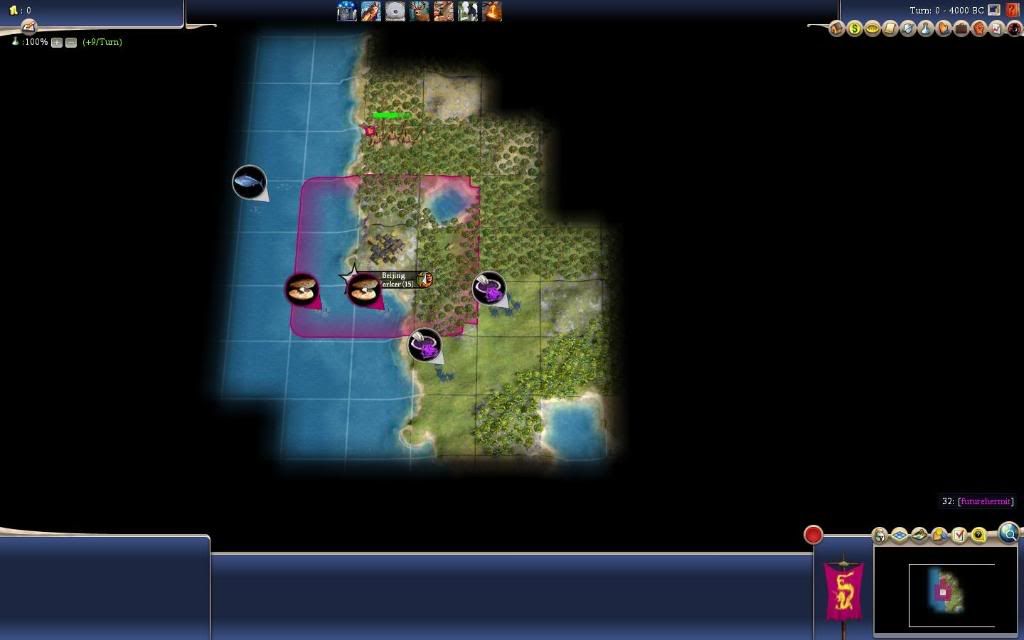


Description
Finally, my old nemesis, the coastal start. I used to always hate coastal starts, but have recently changed my tune since I learned the power of the great light house (GLH). The GLH is an incredibly powerful wonder if used properly. The key is to prioritize coastal city locations and target currency and compass (harbors) to exploit a trade route economy (TRE). Open borders/peace is important for this economy so having room to expand is nice and getting astronomy reasonably early for the overseas trade routes is also nice. GLH helps overcome the difficulty many coastal starts present in terms of having to expand in certain directions only instead of in a ring around your capital. This creates higher maintenance issues as you move further and further inland. Moving your capital becomes an option--if you have a quality, inland, central location--but GLH is a nice way of helping to manage the costs by essentially paying the bills for every coastal city you build. If you can get some cities on islands or other landmasses that increases the value of your trade routes, so that is a solid idea. Without the GLH I would say these starts are reasonably challenging compared to a nice inland start.
Good Fit
Industrious is excellent here since the GLH isn't boosted by any resource (e.g., stone/marble). Organized for the cheap lighthouses is also nice, as is expansive for the cheap harbors. Fishing is obviously a nice starting tech, as is mining to access BW right away. Financial is handy as well since you should be working at least a number of coastal seafood, so the commerce boost is handy. Add in the colossus for extra fun.
Edit: Adding Gold/Gems/Silver capital as requested. Also adding heavy floodplains capital as a unique situation.
The Gold/Gems/Silver Capital AKA The ***salivate while watching screen*** Capital
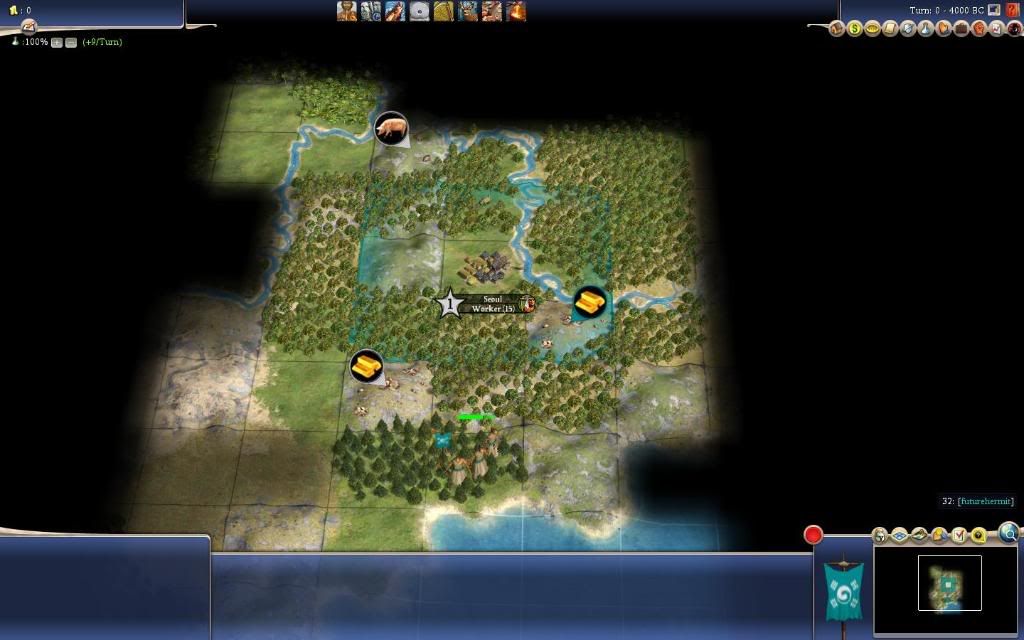

Description
If you have 1 or especially if you have 2+ gold/gems/silver tiles in your capital you have a special situation on your hands. These rare, but excellent, capitals often give experienced players the sense that they should restart because they are "too good". Well, if you're a newer player trying to get better these capitals can help bolster your confidence. The question is: How do you leverage them? These tiles give incredible amounts of commerce meaning your research will be MUCH faster than normal. That means you can often get classical/medieval era techs much faster than normal. In particular, CS unlocks bureaucracy to further improve your powerful capital and being able to tech math/col very quickly means you could potentially nab CS off of the oracle. Alternatively, oracle grabs such as feudalism or machinery are quite plausible with a 2 gold pit start. Teching quickly through important techs like currency and construction are also much, much easier with starts like this. With these 2 techs you can go on a conquering rampage and have the economy to support your conquered empire.
Good Fit
Financial obviously helps make a great thing even better here. Industrious for oracle is also helpful. Charismatic to work even more tiles. Expansive for the vertical growth. These are just some ideas. The key here is to leverage your commerce into an early technological advantage. Funding horizontal expansion is much easier in these situations, making creative/organized/imperialistic desirable as well. You can't go wrong really with this kind of start. Starting techs, basically mining is key and anything to help feed your capital, with ag being a priority assuming it is inland.
The Heavy Floodplains Capital AKA The Potentially Dangerous Capital
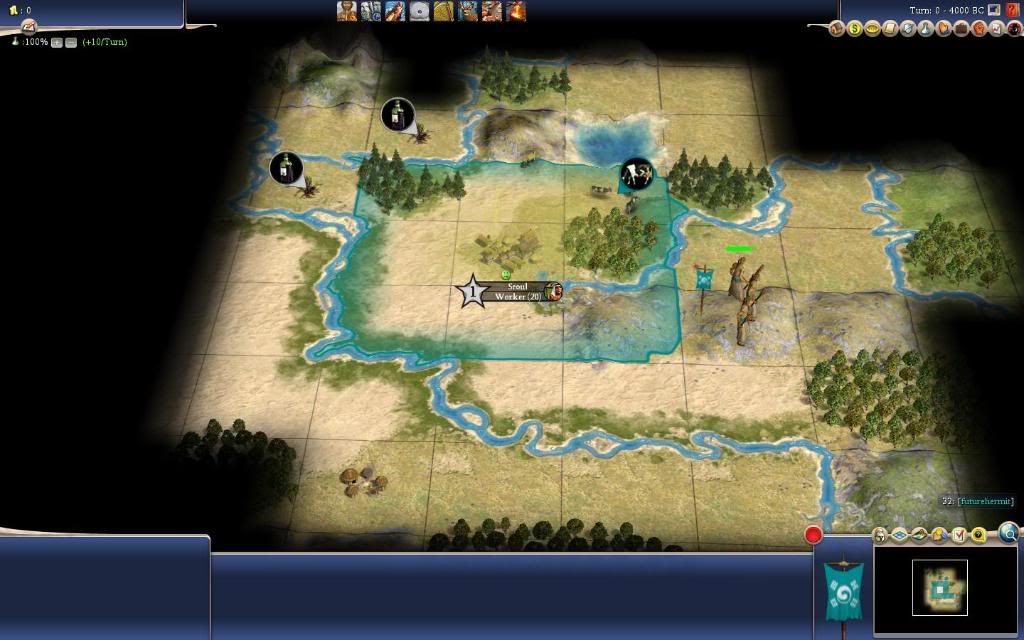
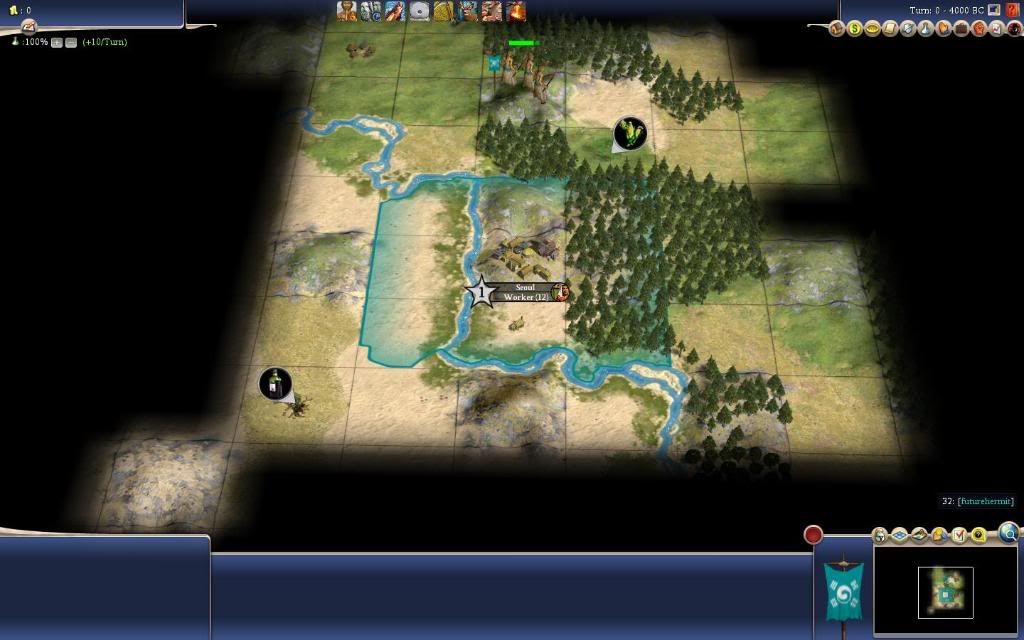

Description
These rare capitals are potentially dangerous because of the health implications. Although it is true that the surplus food can, in time, overcome the health problems, the immediate unhealthiness (see the first screenshot taken immediately upon settling) can have damaging consequences. When you have no health resources hooked up, and potentially few forests, your very slow early growth can lead to much slower expansion times, which can hurt your overall empire development. If you get one of these starts instead of settling in place automatically, it can be a much, much better idea to try and move your settler to a location where you can split the floodplains between two or more cities. Hey, floodplains are a great tile, but too much of a good thing can be bad if you get it all at once. So, to avoid a floodplains overdose, I recommend spreading the love around so you can manage the unhealthiness. In these situations getting a granary and looking for rice/wheat/corn becomes a priority, as does any other health resource. Aqueducts are also more of a priority than usual.
Good Fit
Expansive ftw. Extra health immediately and cheap granaries means you can manage the good stuff here much easier than other civs. Take advantage and hit hereditary rule early enough that you can grow large and work all those sexy cottaged riverside grasslands on steroids.
Conclusion
Bad fit for the different cities is largely the opposite. If you are playing Boudica you generally want a respectable production city and a close neighbour or two so you can go bash some heads. Getting a coastal city and distant neighbours isn't exactly what you had in mind. If you are playing Pacal and hoped for a bureaucracy capital, you might be disappointed to get an obvious gpfarm-style capital since it screams for a SE (you could consider moving your capital and the surrounding terrain may still support a CE or hybrid).
I think the important message here is to try to recognize the kind of capital you have and the style of play it supports and then try to plan accordingly. Even if you are playing say Toku and get a high production/forested start, you may decide not to rush because it would cripple your already fragile economy. But what to do??? In this case, you may opt to wonderspam as much as possible to generate gp that you can settle. Even some settled GPs would help pay the bills to support your subsequent expasion efforts. Add in pyramids/representation for some extra beakers and you are all set for a medieval war featuring samurai churned out of your production monster capital (add in bureaucracy purely for the production bonus).
Capitals are generally your most important cities because they come first and feature the most development as compared to newly founded cities later in the game. The capital can also benefit from the powerful bureaucracy civic increasingly its potency.
I also feel like different traits and starting techs provide good or bad (or in between) "fit" with the different capital types, so I will mention that as well. Feel free to agree/disagree and chime in on your own thoughts about this.
Without further ado, here are the 4 types:
Bureaucracy Capital aka Commerce Capital:



Description
This is the kind of capital, usually on a river, where you can build 10+ grassland/floodplain cottages--mostly riverside--and have more than one food specials to drive growth. Ideally you will also have some nice production tiles, and the food to work them, since bureaucracy also impacts production. However, the key here is working a pile of cottages to drive research and support the costs of a growing empire.
Good Fit
This capital provides a good fit for a variety of strategies. However, traits such as charismatic (
 ), financial (
), financial (  ), and expansive (
), and expansive (  ) probably fit best. Health, happiness, and the extra commerce is what it's all about here. Monarchy is a key tech for the HR civic to drive vertical growth. CS for bureaucracy is also key. Teching Monarchy --> CS by 1AD (normal speed/monarch) is a good timeline for this capital. Getting an academy off of a GS is also key. In terms of starting techs, whatever you need to grow is important. Since you are inland (generally) that usually means agriculture is a good starting tech leading to animal husbandry. Wheel is also helpful as a prereq for pottery, especially if you have floodplains. I would say that ag-wheel might represent the best starting techs for this kind of capital, but mining is not without its merits either.
) probably fit best. Health, happiness, and the extra commerce is what it's all about here. Monarchy is a key tech for the HR civic to drive vertical growth. CS for bureaucracy is also key. Teching Monarchy --> CS by 1AD (normal speed/monarch) is a good timeline for this capital. Getting an academy off of a GS is also key. In terms of starting techs, whatever you need to grow is important. Since you are inland (generally) that usually means agriculture is a good starting tech leading to animal husbandry. Wheel is also helpful as a prereq for pottery, especially if you have floodplains. I would say that ag-wheel might represent the best starting techs for this kind of capital, but mining is not without its merits either.GP Farm Capital aka Food Capital:



Description
These capitals are often on the coast. Because there are a number of coastal tiles, cottages are less of an option making bureaucracy less potent. These capitals also generally have incredible food surplus making the capital ideal for running specialists. Settled great people supports research or bulbing and tech trading is a powerful option as well, especially at higher skill levels. Earlier on, these cities make extremely powerful whip-driven-production cities (slavery).
Good Fit
Philosophical is a natural and powerful fit here, but industrious (pyramids/gl/glh/ne/parthenon) can be helpful assuming sufficient production and/or stone/marble. Expansive for the vertical growth is also not without its charm. In terms of starting techs it's all about food. Since these capitals tend to, on average, be on the coast, fishing is nice. Agriculture is also good. Ag/fishing might be a nice starting tech pair although mining is also good since it leads to BW for the whipping. CoL is important because it unlocks caste system and also frees up a philosophy lightbulb for the pacifism civic.
Production Capital aka Hammer/Low Food Capital:



Description
These capitals are fairly unique to BTS as they did not appear in vanilla/warlords--at least not with the same frequency. They generally feature low food in the sense that you need to lay down grassland farms to support all of the production (i.e., hills) that you have. Interestingly, these capitals also tend to be nearly completely blanketed in forests, which adds to your production potential. Growing quickly and whipping is generally not an option here and cottages are pretty much out of the question. Because of the low food specialists are also not an option. That means research from your capital is generally not happening, at least not in the traditional sense of specialists and cottages. However, Obsolete and others like him have turned us on to the wonder/production economy of cranking out wonder after wonder and settling the great people under representation. This is a powerful alternative for this unusual capital location in order to keep research at acceptable levels.
Another alternative for this capital location is rushing or rexing. Although these options are also available for the bureaucracy capital to a certain extent, the production capital has the production available to chop and hard produce a lot of military quickly or workers/settlers to expand your military horizontally. Unfortunately, your capital doesn't provide you with the commerce to support this expansion so you should be prepared to develop this economic support from your conquests and/or your newly created/captured cities. Otherwise you risk overexpansion and stifling your economy.
Good Fit
If you go the wonder route industrious is obviously handy to have although philosophical is beneficial as well. Mining is the key starting tech here because you're going to need BW sooner than later to start chopping all of those forests (at the very least you will probably need to chop a few so you can mine some hills or farm riverside grassland). In terms of a tech route you're going to be looking at mysticism/masonry and the other wonder-enabling techs.
If you go the rexing or rushing route aggressive, charismatic, imperialistic, expansive, creative, organized can all be quite helpful. Mining is still important, and BW is key. AH can also be important, especially if you don't have copper and/or have a lot of animal food resources. Getting to the key economic techs like currency/col are quite essential in these situations, especially since your capital is not churning out commerce.
Coastal Capital aka "Great Lighthouse" Capital:



Description
Finally, my old nemesis, the coastal start. I used to always hate coastal starts, but have recently changed my tune since I learned the power of the great light house (GLH). The GLH is an incredibly powerful wonder if used properly. The key is to prioritize coastal city locations and target currency and compass (harbors) to exploit a trade route economy (TRE). Open borders/peace is important for this economy so having room to expand is nice and getting astronomy reasonably early for the overseas trade routes is also nice. GLH helps overcome the difficulty many coastal starts present in terms of having to expand in certain directions only instead of in a ring around your capital. This creates higher maintenance issues as you move further and further inland. Moving your capital becomes an option--if you have a quality, inland, central location--but GLH is a nice way of helping to manage the costs by essentially paying the bills for every coastal city you build. If you can get some cities on islands or other landmasses that increases the value of your trade routes, so that is a solid idea. Without the GLH I would say these starts are reasonably challenging compared to a nice inland start.
Good Fit
Industrious is excellent here since the GLH isn't boosted by any resource (e.g., stone/marble). Organized for the cheap lighthouses is also nice, as is expansive for the cheap harbors. Fishing is obviously a nice starting tech, as is mining to access BW right away. Financial is handy as well since you should be working at least a number of coastal seafood, so the commerce boost is handy. Add in the colossus for extra fun.
Edit: Adding Gold/Gems/Silver capital as requested. Also adding heavy floodplains capital as a unique situation.
The Gold/Gems/Silver Capital AKA The ***salivate while watching screen*** Capital


Description
If you have 1 or especially if you have 2+ gold/gems/silver tiles in your capital you have a special situation on your hands. These rare, but excellent, capitals often give experienced players the sense that they should restart because they are "too good". Well, if you're a newer player trying to get better these capitals can help bolster your confidence. The question is: How do you leverage them? These tiles give incredible amounts of commerce meaning your research will be MUCH faster than normal. That means you can often get classical/medieval era techs much faster than normal. In particular, CS unlocks bureaucracy to further improve your powerful capital and being able to tech math/col very quickly means you could potentially nab CS off of the oracle. Alternatively, oracle grabs such as feudalism or machinery are quite plausible with a 2 gold pit start. Teching quickly through important techs like currency and construction are also much, much easier with starts like this. With these 2 techs you can go on a conquering rampage and have the economy to support your conquered empire.
Good Fit
Financial obviously helps make a great thing even better here. Industrious for oracle is also helpful. Charismatic to work even more tiles. Expansive for the vertical growth. These are just some ideas. The key here is to leverage your commerce into an early technological advantage. Funding horizontal expansion is much easier in these situations, making creative/organized/imperialistic desirable as well. You can't go wrong really with this kind of start. Starting techs, basically mining is key and anything to help feed your capital, with ag being a priority assuming it is inland.
The Heavy Floodplains Capital AKA The Potentially Dangerous Capital



Description
These rare capitals are potentially dangerous because of the health implications. Although it is true that the surplus food can, in time, overcome the health problems, the immediate unhealthiness (see the first screenshot taken immediately upon settling) can have damaging consequences. When you have no health resources hooked up, and potentially few forests, your very slow early growth can lead to much slower expansion times, which can hurt your overall empire development. If you get one of these starts instead of settling in place automatically, it can be a much, much better idea to try and move your settler to a location where you can split the floodplains between two or more cities. Hey, floodplains are a great tile, but too much of a good thing can be bad if you get it all at once. So, to avoid a floodplains overdose, I recommend spreading the love around so you can manage the unhealthiness. In these situations getting a granary and looking for rice/wheat/corn becomes a priority, as does any other health resource. Aqueducts are also more of a priority than usual.
Good Fit
Expansive ftw. Extra health immediately and cheap granaries means you can manage the good stuff here much easier than other civs. Take advantage and hit hereditary rule early enough that you can grow large and work all those sexy cottaged riverside grasslands on steroids.
Conclusion
Bad fit for the different cities is largely the opposite. If you are playing Boudica you generally want a respectable production city and a close neighbour or two so you can go bash some heads. Getting a coastal city and distant neighbours isn't exactly what you had in mind. If you are playing Pacal and hoped for a bureaucracy capital, you might be disappointed to get an obvious gpfarm-style capital since it screams for a SE (you could consider moving your capital and the surrounding terrain may still support a CE or hybrid).
I think the important message here is to try to recognize the kind of capital you have and the style of play it supports and then try to plan accordingly. Even if you are playing say Toku and get a high production/forested start, you may decide not to rush because it would cripple your already fragile economy. But what to do??? In this case, you may opt to wonderspam as much as possible to generate gp that you can settle. Even some settled GPs would help pay the bills to support your subsequent expasion efforts. Add in pyramids/representation for some extra beakers and you are all set for a medieval war featuring samurai churned out of your production monster capital (add in bureaucracy purely for the production bonus).

 ).
). 


 forego bureaucracy and focus on the lesser-used vassalage. Running a SE has great synergy with warmongering afterall
forego bureaucracy and focus on the lesser-used vassalage. Running a SE has great synergy with warmongering afterall